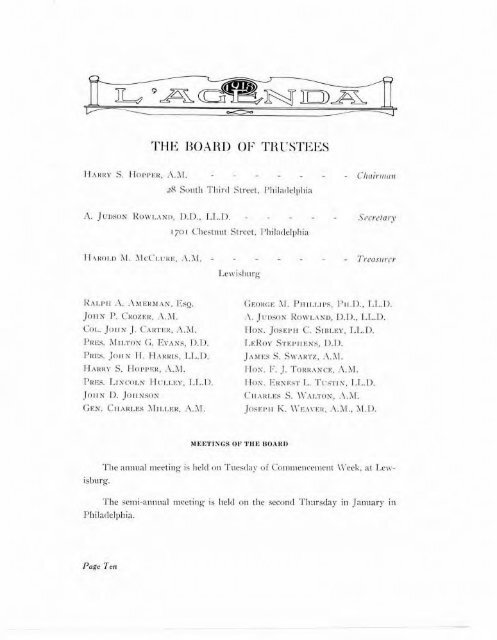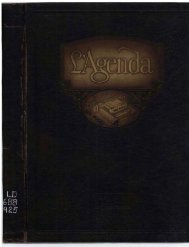1 - Library and Information Technology - Bucknell University
1 - Library and Information Technology - Bucknell University
1 - Library and Information Technology - Bucknell University
- No tags were found...
Create successful ePaper yourself
Turn your PDF publications into a flip-book with our unique Google optimized e-Paper software.
BOYSEN_STEP125/23/2011 11:35:44 AM318 ST. MARY’S JOURNAL ON LEGAL MALPRACTICE & ETHICS [Vol. 1:308on the plaintiff to prove not only the elements of the malpractice case ath<strong>and</strong>, but also that he would have been successful in the underlying case. 31The second element of causation is proximate causation. 32 Thequestion of proximate causation is essentially a question of whether it isfair to impose liability for the injury that occurred. 33 In other words,proximate causation determines that even where factual causation exists,liability will not be imposed unless it is fair to do so. 34 Foreseeability <strong>and</strong>cause-in-fact are the two elements of establishing proximate causation, <strong>and</strong>the existence of both elements makes it fair to impose liability upon theof the attorney); Mackie, 900 S.W.2d at 449 (detailing the suit-within-a-suit requirement <strong>and</strong>explaining but-for causation); Gibson v. Johnson, 414 S.W.2d 235, 238–39 (Tex. Civ. App.—Tyler1967, writ ref’d n.r.e.) (explaining the suit-within-a-suit approach to establishing causation). “[T]heplaintiff would have to conduct a ‘trial within a trial’ in which both the malpractice <strong>and</strong> theunderlying claims are tried to the same jury, with the malpractice defendant forced to represent theopponent in the underlying action.” Lawyers’ Responsibilities to the Client, supra note 7, at 1568.31. Mackie, 900 S.W.2d at 449; Jackson, 516 S.W.2d at 949; see also VINCENT R. JOHNSON,LEGAL MALPRACTICE LAW IN A NUTSHELL 107–08 (2011) (detailing the but-for test of factualcausation <strong>and</strong> stating that the plaintiff must show that but for the negligence of the defendantattorney,the plaintiff would have won the underlying case). “In a situation involving the attorneyclientrelationship where the client seeks to recover against his attorney on the ground that the lattercaused him to lose his cause of action, the burden of proof is on the client to prove that his suitwould have been successful but for the negligence of his attorney, <strong>and</strong> to show what amount wouldhave been collectible had he recovered judgment.” Gibson, 414 S.W.2d at 238–39; see also Koffler,supra note 28, at 65–66 (explaining the burden on the plaintiff to prove the trial within a trial).“[T]he plaintiff must prove by a preponderance of the evidence that, but for the defendant lawyer’smisconduct, the plaintiff would have obtained a more favorable judgment in the previous action.”RESTATEMENT (THIRD) OF LAW GOVERNING LAWYERS § 53 cmt. b (2000). “‘But for’ causation isoften difficult to establish.” VINCENT R. JOHNSON, LEGAL MALPRACTICE LAW IN A NUTSHELL103 (2011). “[E]ven if an attorney was negligent in not filing an action within the statute oflimitations, if the client cannot establish that his case would have been meritorious, no damages areshown <strong>and</strong> no recovery can be had.” Nika v. Danz, 556 N.E.2d 873, 882 (Ill. App. Ct. 1990).32. See 7A C.J.S. Attorney <strong>and</strong> Client § 302 (2010) (explaining causation requires both factual<strong>and</strong> proximate causation); see also VINCENT R. JOHNSON, LEGAL MALPRACTICE LAW IN ANUTSHELL 117–18 (2011) (describing proximate causation as an element of causation); Mahaffey,supra note 21, at 407–09 (detailing factual <strong>and</strong> proximate causation).33. See VINCENT R. JOHNSON, LEGAL MALPRACTICE LAW IN A NUTSHELL 117 (2011) (“Therequirement of proximate causation is a policy-based inquiry into fairness.”); Mahaffey, supra note21, at 408 (explaining that proximate cause is essentially whether that person should be responsiblefor what occurred).34. See VINCENT R. JOHNSON, LEGAL MALPRACTICE LAW IN A NUTSHELL 117 (2011)(explaining proximate causation <strong>and</strong> stating that even when the defendant has factually caused theharm, there will be no liability unless it is fair to impose it); Mahaffey, supra note 21, at 408(“Proximate cause, however, accepts that the defendant’s action was a cause of the plaintiff’s allegedinjury but seeks to determine ‘whether that tortuous cause should be treated as a proximate(responsible) cause.’” (emphasis omitted) (quoting Richard W. Wright, Causation, Responsibility,Risk, Probability, Naked Statistics, <strong>and</strong> Proof: Pruning the Bramble Bush by Clarifying the Concepts, 73IOWA L. REV. 1001, 1011 (1988))).
















